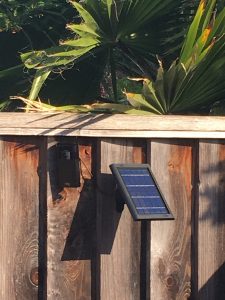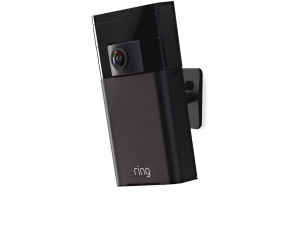I have been looking for ways to mount security cameras around my house to get good coverage of all doors and windows. If the cameras can be mounted in the yard, pointing towards the house, it is possible to get large areas covered with a relatively smaller number of cameras. That would mean that the cameras would need to be powered outside of the house. One option would be to run low-voltage wiring from the house to each of the cameras. These could be either power lines or ethernet cables, if the cameras supported power-over-ethernet (POE). The wires would have to be well protected and run underground in many places around the house. That makes it very challenging to install and maintain the cameras over time — in case the external wiring deteriorates over time.
Solar powered cameras would be a good alternative, but they need to have a rechargeable battery to provide power during the night. The Ring Stick-up Cam does exactly that. It has a rechargeable battery that can either be charged periodically or by a solar panel if connected.
The camera costs about $160 and the optional solar panel around $45, and the combo costs around $200. The price is competitive with other security cameras such as the Nest. But it is the simplicity and the ease of installation of the Ring Stick-up Cam that makes it so attractive.
The camera and the solar panel come with all the required cables, mounting brackets, screws, and even a drill-bit and a screwdriver! Mounting the camera and the solar panel on a wooden fences takes only a few minutes. Setting up the Wifi on the camera is easy, just as it is with other cameras like the Nest. I had my Ring camera installed on my fence and tested in less than about 30 minutes!

Powering the camera
The camera comes with a built-in rechargeable battery. There are really three options for powering the camera.
- using only the battery;
- using the battery with the optional solar panel to charge it during the day;
- powering the camera with an USB cable which also charges the battery
Ring claims that a fully charged battery should last a few months with normal use. But if the camera goes active a lot due to motion detection or user-initiated live views, the battery is likely to run down soon. So if you are going to mount the camera away from the house — like for example, on the fence — it might be a good idea to go with the solar option.
Connectivity
The camera connects to your home network with 2,4 GHz WiFi. Setting up the camera to connect to the network with your SSID is quick using the smartphone app.
Monitoring and Storing
Once the camera is set up, you can use the app to enable motion detection, and also select which areas in the field of view where motion detection should trigger recurring and notifications. That way, you can prevent the camera from false-triggering on movement of things like branches of trees, etc. When the camera detects some movement in the areas that are enabled, it uploads video and audio as long as it sees movement. The media is stored in the cloud that you can access with your Ring account. For $3 a month, you can store media from one camera for up to 60 days. With the $10 a month plan, you can store media from an unlimited number of Ring devices.
Live View
At any time, you can invoke live view from either your smartphone or computer to see what is happening at the site. Live view media is also stored in the cloud, so it is a bit like doing a manual video recording.
So what happens when you are in your backyard, and the camera keep recording you as it detects movement? To prevent this, you can disable motion detection from your smartphone app.
How does it perform?
I got my camera a few days ago, and was able to set it up in my backyard and test it in about 30 minutes. I am still on my trial cloud storage plan, and I have seen recordings of motion and live view from the last couple of days. The picture is amazingly sharp, and the audio is quite clear too., The menu in the smartphone and the computer apps is very intuitive. You can not only view the stored media and mark the ones that are critical, but also monitor the “health” of the camera which includes the states of the battery, WiFi connection, etc.
You can get instant notifications on your smartphone whenever there is motion detected. There are also notifications for events such as network disconnection.
The Final Word
The Ring Stick-up Cam and the Solar Panel make a formidable combination that competes with other external security camera options such as the Nest, Swann, and Lorex camera systems. The ease of set up and the solar power option make it a very attractive option. I like the Nest and Swann cameras that I have, but the simplicity of the Ring Stick-up camera for connectivity and powering really impressed me. I have also discussed the capabilities of this system with my coworkers who have done extensive research on security systems, and almost all of them are planning to get one of these for their homes.





























[…] Review: Ring Stick-up Cam with Solar Panel (Jun 21, […]